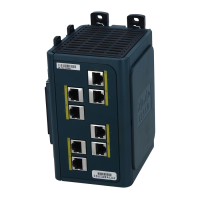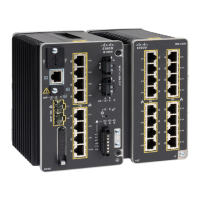984
Configuring Enhanced Object Tracking
Configuring Enhanced Object Tracking Features
Configuring a Cisco IP SLAs Monitoring Agent and Track Object
Beginning in privileged EXEC mode, follow these steps to configure network monitoring with Cisco IP SLAs:
Configuring a Routing Policy and Default Route
Beginning in privileged EXEC mode, follow these steps to configure a routing policy for backup static routing by using
object tracking. For more details about the commands in the procedure, see this URL:
http://www.cisco.com/en/US/docs/ios/12_3/12_3x/12_3xe/feature/guide/dbackupx.html
:
1. configure terminal Enter global configuration mode.
2. ip sla operation-number Begin configuring a Cisco IP SLAs operation and enter IP SLA
configuration mode.
3. icmp-echo {destination-ip-address |
destination hostname [source- ipaddr
{ip-address | hostname source-interface
interface-id]
Configure a Cisco IP SLAs end-to-end ICMP echo response time
operation and enter IP SLAs ICMP echo configuration mode.
4. timeout milliseconds Set the amount of time for which the operation waits for a response
from its request packet.
5. frequency seconds Set the rate at which the operation is sent into the network.
6. threshold milliseconds Set the rising threshold (hysteresis) that generates a reaction event
and stores history information for the operation.
7. exit Exit IP SLAs ICMP echo configuration mode.
8. ip sla schedule operation-number [life
{forever | seconds}] start-time time |
pending | now | after time] [ageout
seconds] [recurring]
Configure the scheduling parameters for a single IP SLAs operation.
9. { track object-number rtr operation-number
{state | reachability}
Track the state of a Cisco IOS IP SLAs operation and enter tracking
configuration mode.
10. end Return to privileged EXEC mode.
11. show track object-number Display tracking information to verify the configuration.
12. copy running-config startup-config (Optional) Save your entries in the configuration file.
1. configure terminal Enter global configuration mode.
2. access-list access-list-number Define an extended IP access list. Configure any optional
characteristics.
3. route-map map-tag [permit | deny]
[sequence-number]
Enter route-map configuration mode and define conditions for
redistributing routes from one routing protocol to another.
4. match ip address {access-list number |
access-list name}
Distribute any routes that have a destination network number address
that is permitted by a standard or extended access list or performs
policy routing on packets. You can enter multiple numbers or names.
5. set ip next-hop dynamic dhcp For DHCP networks only. Set the next hop to the gateway that was
most recently learned by the DHCP client.
6. set interface interface-id For static routing networks only. Indicate where to send output
packets that pass a match clause of a route map for policy routing.
7. exit Exit route-map configuration mode.
8. ip local policy route-map map-tag Identify a route map to use for local policy routing.

